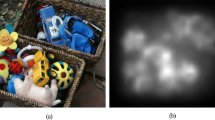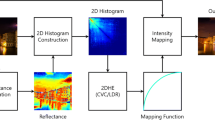Abstract
Spectrum normalization is a process shared by two saliency detection methods, Spectral Residual (SR) and Phase Fourier Transform (PFT). In this paper, we point out that the essence of spectrum normalization is the re-allocation of energy. By re-allocating normalized energy in particular frequency region to the whole background, the salient objects are effectively highlighted and the energy of the background is weakened. Considering energy distribution in both spectral domain and color channels, we propose a simple and effective visual saliency model based on Energy Re-allocation mechanism (ER). We combine color energy normalization, spectrum normalization and channel energy normalization to attain an energy re-allocation map. Then, we convert the map to the corresponding saliency map using a low-pass filter. Compared with other state-of-the-art models, experiments on both natural images and psychological images indicate that ER can better detect the salient objects with a competitive computational speed.
Access this chapter
Tax calculation will be finalised at checkout
Purchases are for personal use only
Preview
Unable to display preview. Download preview PDF.
Similar content being viewed by others
References
Hou, X., Zhang, L.: Dynamic Visual Attention: Searching for Coding Length Increments. In: NIPS, vol. 20 (2008)
Wang, Y.S., Tai, C.W., Sorkine, O., Lee, T.Y.: Optimized Scale-and-Stretch for Image Resizing. SIGGRAPH ASIA (2008)
Itti, L., Koch, C., Niebur, E.: A model of Saliency-based Visual Attention for Rapid Scene Analysis. TPAMI 20, 1254–1259 (1998)
Bruce, N., Tsotsos, J.: Saliency Based on Information Maximization. In: NIPS, vol. 18 (2006)
Gao, D., Vasconcelos, N.: Bottom-up Saliency is A Discriminant Process. In: ICCV (2007)
Gao, D., Vasconcelos, N.: An Experimental Comparison of Three Guiding Principles for The Detection Salient Image Locations: Stability, Complexity, and Discrimination. In: CVPR workshops (2005)
Lowe, D.G.: Object Recognition from Local Scale-invariant Features. In: ICCV (1999)
Sebe, N., Lew, M.S.: Comparing Salient Point Detectors. In: ICME (2001)
Kadir, T., Brady, M.I.: Scale, Saliency and Image Description. IJCV 45, 83–105 (2001)
Achanta, R., Hemami, S., Estrada, F., Süsstrunk, S.: Frequency-tuned Salient Region Detection. In: CVPR (2009)
Hou, X., Zhang, L.: Saliency Detection: A Spectral Residual Approach. In: CVPR (2007)
Guo, C., Ma, Q., Zhang, L.: Spatio-temporal Saliency Detection Using Phase Spectrum of Quaternion Fourier Transform. In: CVPR (2008)
Field, D.J.: Relations Between the Statistics of Natural Images and The Response Properties of Cortical Cells. JOSA A 4, 2379–2394 (1987)
Field, D.J.: What is the Goal of Sensory Coding? Source Neural Computation archive 6, 559–601 (1994)
He, D.-C., Wang, L.: Texture Unit, Texture Spectrum, and Texture Analysis. TGRS 28, 509–512 (1990)
Oppenheim, A.V., Lim, J.S.: The Importance of Phase in Signals. Proceedings of the IEEE 69, 529–541 (1981)
Wolfe, J.M.: Asymmetries in Visual Search: An Introduction. Perception and psychophysics 63, 381–389 (2001)
Author information
Authors and Affiliations
Editor information
Editors and Affiliations
Rights and permissions
Copyright information
© 2010 Springer-Verlag Berlin Heidelberg
About this paper
Cite this paper
Kang, Z., Zhang, J. (2010). Color Spectrum Normalization: Saliency Detection Based on Energy Re-allocation. In: Qiu, G., Lam, K.M., Kiya, H., Xue, XY., Kuo, CC.J., Lew, M.S. (eds) Advances in Multimedia Information Processing - PCM 2010. PCM 2010. Lecture Notes in Computer Science, vol 6297. Springer, Berlin, Heidelberg. https://doi.org/10.1007/978-3-642-15702-8_23
Download citation
DOI: https://doi.org/10.1007/978-3-642-15702-8_23
Publisher Name: Springer, Berlin, Heidelberg
Print ISBN: 978-3-642-15701-1
Online ISBN: 978-3-642-15702-8
eBook Packages: Computer ScienceComputer Science (R0)




